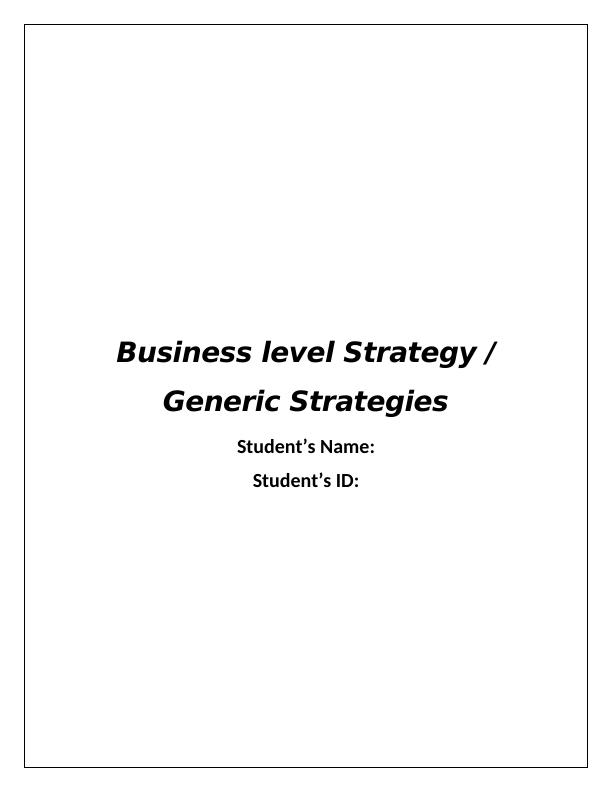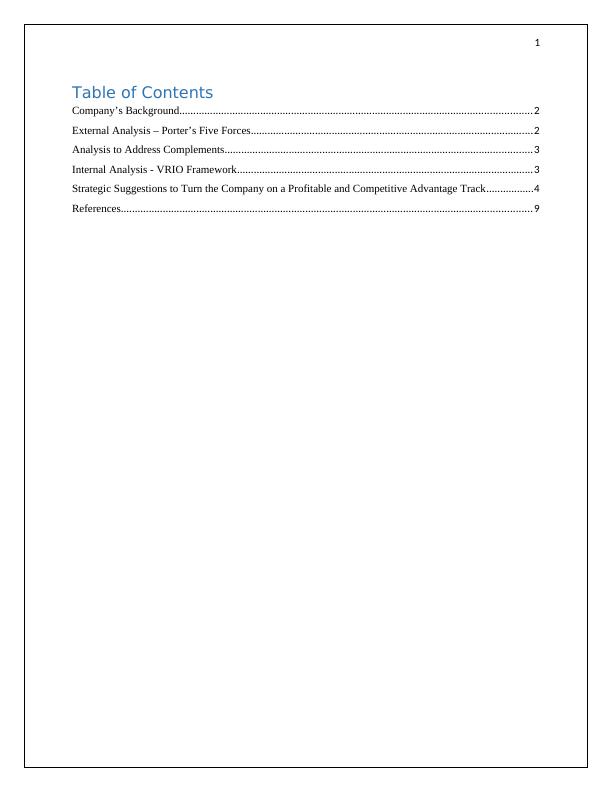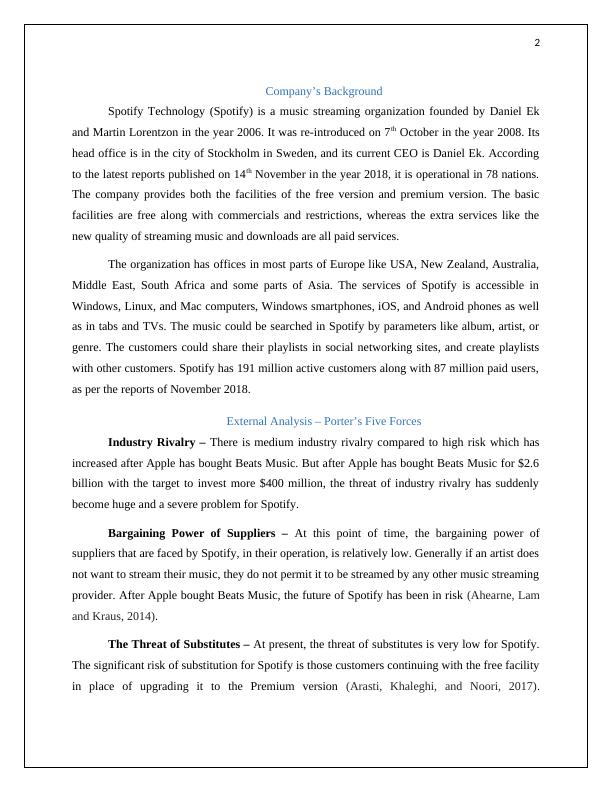Business Level Strategy for Spotify Technology
Added on 2023-05-29
11 Pages3751 Words162 Views
Business level Strategy /
Generic Strategies
Student’s Name:
Student’s ID:
Generic Strategies
Student’s Name:
Student’s ID:

1
Table of Contents
Company’s Background..............................................................................................................................2
External Analysis – Porter’s Five Forces.....................................................................................................2
Analysis to Address Complements..............................................................................................................3
Internal Analysis - VRIO Framework..........................................................................................................3
Strategic Suggestions to Turn the Company on a Profitable and Competitive Advantage Track.................4
References...................................................................................................................................................9
Table of Contents
Company’s Background..............................................................................................................................2
External Analysis – Porter’s Five Forces.....................................................................................................2
Analysis to Address Complements..............................................................................................................3
Internal Analysis - VRIO Framework..........................................................................................................3
Strategic Suggestions to Turn the Company on a Profitable and Competitive Advantage Track.................4
References...................................................................................................................................................9

2
Company’s Background
Spotify Technology (Spotify) is a music streaming organization founded by Daniel Ek
and Martin Lorentzon in the year 2006. It was re-introduced on 7th October in the year 2008. Its
head office is in the city of Stockholm in Sweden, and its current CEO is Daniel Ek. According
to the latest reports published on 14th November in the year 2018, it is operational in 78 nations.
The company provides both the facilities of the free version and premium version. The basic
facilities are free along with commercials and restrictions, whereas the extra services like the
new quality of streaming music and downloads are all paid services.
The organization has offices in most parts of Europe like USA, New Zealand, Australia,
Middle East, South Africa and some parts of Asia. The services of Spotify is accessible in
Windows, Linux, and Mac computers, Windows smartphones, iOS, and Android phones as well
as in tabs and TVs. The music could be searched in Spotify by parameters like album, artist, or
genre. The customers could share their playlists in social networking sites, and create playlists
with other customers. Spotify has 191 million active customers along with 87 million paid users,
as per the reports of November 2018.
External Analysis – Porter’s Five Forces
Industry Rivalry – There is medium industry rivalry compared to high risk which has
increased after Apple has bought Beats Music. But after Apple has bought Beats Music for $2.6
billion with the target to invest more $400 million, the threat of industry rivalry has suddenly
become huge and a severe problem for Spotify.
Bargaining Power of Suppliers – At this point of time, the bargaining power of
suppliers that are faced by Spotify, in their operation, is relatively low. Generally if an artist does
not want to stream their music, they do not permit it to be streamed by any other music streaming
provider. After Apple bought Beats Music, the future of Spotify has been in risk (Ahearne, Lam
and Kraus, 2014).
The Threat of Substitutes – At present, the threat of substitutes is very low for Spotify.
The significant risk of substitution for Spotify is those customers continuing with the free facility
in place of upgrading it to the Premium version (Arasti, Khaleghi, and Noori, 2017).
Company’s Background
Spotify Technology (Spotify) is a music streaming organization founded by Daniel Ek
and Martin Lorentzon in the year 2006. It was re-introduced on 7th October in the year 2008. Its
head office is in the city of Stockholm in Sweden, and its current CEO is Daniel Ek. According
to the latest reports published on 14th November in the year 2018, it is operational in 78 nations.
The company provides both the facilities of the free version and premium version. The basic
facilities are free along with commercials and restrictions, whereas the extra services like the
new quality of streaming music and downloads are all paid services.
The organization has offices in most parts of Europe like USA, New Zealand, Australia,
Middle East, South Africa and some parts of Asia. The services of Spotify is accessible in
Windows, Linux, and Mac computers, Windows smartphones, iOS, and Android phones as well
as in tabs and TVs. The music could be searched in Spotify by parameters like album, artist, or
genre. The customers could share their playlists in social networking sites, and create playlists
with other customers. Spotify has 191 million active customers along with 87 million paid users,
as per the reports of November 2018.
External Analysis – Porter’s Five Forces
Industry Rivalry – There is medium industry rivalry compared to high risk which has
increased after Apple has bought Beats Music. But after Apple has bought Beats Music for $2.6
billion with the target to invest more $400 million, the threat of industry rivalry has suddenly
become huge and a severe problem for Spotify.
Bargaining Power of Suppliers – At this point of time, the bargaining power of
suppliers that are faced by Spotify, in their operation, is relatively low. Generally if an artist does
not want to stream their music, they do not permit it to be streamed by any other music streaming
provider. After Apple bought Beats Music, the future of Spotify has been in risk (Ahearne, Lam
and Kraus, 2014).
The Threat of Substitutes – At present, the threat of substitutes is very low for Spotify.
The significant risk of substitution for Spotify is those customers continuing with the free facility
in place of upgrading it to the Premium version (Arasti, Khaleghi, and Noori, 2017).

3
Advertisements are playing on the free facility to produce profits for Spotify, although their final
aim is to get more paid customers.
Bargaining Power of Buyers – There is low bargaining power of customers and Spotify
fully manages this field. The company have the regular and free service given to every customer
and propose the facility of premium version for the persons who want to listen to songs offline.
(Bentley-Goode, Newton and Thompson, 2017). The bargaining power of the customers could
be increased in future, and so Spotify has to remain competitive to tackle Apple.
The Threat of New Entrants – The threat of new entrants is very low for Spotify. The
market of the streaming music is relatively down, and the acquisition of Beats Music by Apple
would most probably discourage entry the new competitors (Campbell, 2017).
Analysis to Address Complements
The complements have a powerful effect on the industry, and it is sometimes taken as the
sixth force. The services provided by Spotify differ from other companies of music streaming.
Spotify is comparatively constrained in a matter of alternatives. Rdio and Beats Music offer
more search options, and Rdio is nearly open of all its information to their developers (Dyer and
Song, 2015). All the three companies have the potential to manage and save information with the
help of API, starting from managing and rating the playlists up to assessing and managing every
personal knowledge of the customers.
Internal Analysis - VRIO Framework
Value – Spotify has some resources or plans which could use the opportunities and
protect the organization from future dangers. The funds are also necessary when they give
satisfaction to the users and increase the value of the users. This value is built to enhance the
differences in current plans of music streaming or decrease the service costs of the paid
subscribers (Engert and Baumgartner, 2016). If these are not fulfilled, the organization might
lead to competitive disadvantage. So, it is essential to evaluate the actions and resources values
of Spotify constantly. The company values the customers, so the client has the power to select
their services, but they certainly not have the ability to control Spotify in any other means.
Rareness – If any other organization does not utilize the resources of Spotify, it might
lead to rarity. Rare and important resources increase the competitive advantages of the company.
Advertisements are playing on the free facility to produce profits for Spotify, although their final
aim is to get more paid customers.
Bargaining Power of Buyers – There is low bargaining power of customers and Spotify
fully manages this field. The company have the regular and free service given to every customer
and propose the facility of premium version for the persons who want to listen to songs offline.
(Bentley-Goode, Newton and Thompson, 2017). The bargaining power of the customers could
be increased in future, and so Spotify has to remain competitive to tackle Apple.
The Threat of New Entrants – The threat of new entrants is very low for Spotify. The
market of the streaming music is relatively down, and the acquisition of Beats Music by Apple
would most probably discourage entry the new competitors (Campbell, 2017).
Analysis to Address Complements
The complements have a powerful effect on the industry, and it is sometimes taken as the
sixth force. The services provided by Spotify differ from other companies of music streaming.
Spotify is comparatively constrained in a matter of alternatives. Rdio and Beats Music offer
more search options, and Rdio is nearly open of all its information to their developers (Dyer and
Song, 2015). All the three companies have the potential to manage and save information with the
help of API, starting from managing and rating the playlists up to assessing and managing every
personal knowledge of the customers.
Internal Analysis - VRIO Framework
Value – Spotify has some resources or plans which could use the opportunities and
protect the organization from future dangers. The funds are also necessary when they give
satisfaction to the users and increase the value of the users. This value is built to enhance the
differences in current plans of music streaming or decrease the service costs of the paid
subscribers (Engert and Baumgartner, 2016). If these are not fulfilled, the organization might
lead to competitive disadvantage. So, it is essential to evaluate the actions and resources values
of Spotify constantly. The company values the customers, so the client has the power to select
their services, but they certainly not have the ability to control Spotify in any other means.
Rareness – If any other organization does not utilize the resources of Spotify, it might
lead to rarity. Rare and important resources increase the competitive advantages of the company.

End of preview
Want to access all the pages? Upload your documents or become a member.
Related Documents
Innovation Case Study: Spotifylg...
|10
|2867
|480
